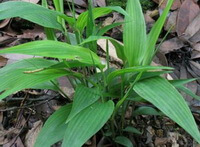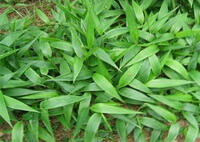Introduction of Dan Zhu Ye:Lophatherum Herb or Herba Lophatheri.
-
 ✵The article gives records of the herb Lophatherum Herb, its English name, Latin name, property and flavor, its botanical source two plant species, ①.Lophatherum gracile Brongn., ②.Lophatherum sinense Rendle., with a detailed introduction to the botanical features of these two plant species, the growth characteristics, and ecological environment of these two plant species, the features of the herb Lophatherum Herb, its pharmacological actions, medicinal efficacy, and administration guide.
✵The article gives records of the herb Lophatherum Herb, its English name, Latin name, property and flavor, its botanical source two plant species, ①.Lophatherum gracile Brongn., ②.Lophatherum sinense Rendle., with a detailed introduction to the botanical features of these two plant species, the growth characteristics, and ecological environment of these two plant species, the features of the herb Lophatherum Herb, its pharmacological actions, medicinal efficacy, and administration guide.
- Herba Lophatheri(Lophatherum Herb).
-
 Pin Yin Name: Dàn Zhú Yè.
Pin Yin Name: Dàn Zhú Yè.
English Name: Lophatherum Herb.
Latin Name: Herba Lophatheri.
Property and flavor: cold, sweet, tasteless.
Brief introduction: The herb Herba Lophatheri is the dried stem and leaf of Lophatherum gracile Brongn., used for relieving fidgetiness and thirst in cases of febrile diseases, and dysuria with painful urination, also known as a bamboo leaf. The herb is commonly known as Common Lophatherum Herb, Common Lophatherum or Dàn Zhú Yè.
Botanical source: The herb Herba Lophatheri (Lophatherum Herb) is the dried stem and leaf of Lophatherum gracile Brongn., it is a plant of the Lophatherum. Genus, the Gramineae family (Poaceae, grass family) of the Poales order.
Herbal classic book defined the herb Herba Lophatheri (Lophatherum Herb) as the dried stem and leaf of (1). Lophatherum gracile Brongn., or (2). Lophatherum sinense Rendle. These 2 commonly used species are introduced:
(1).Lophatherum gracile Brongn.
 Botanical description: Lophatherum gracile Brongn is commonly known as Common Lophatherum or Dan Zhu Ye. A perennial herb, the plant grows up to 40~100 cm tall. The rhizome is thick and short, firm and hard. Fibrous roots are sparse, often enlarged into fusiform tuberous roots in the part near to the top or middle. The rod is slender and fragile, more or less lignified. Leaves are alternate, broadly lanceolate, 5~20 cm long, 1.5~3.0 cm wide, the apex is acuminate or mucronate (short pointed), entire, the base is orbicular (subrotund) or cuneate and gradually narrowing to petiole or is sessile, many parallel veins, with conspicuous transverse veins, in a small long square shape, both surfaces are glabrous or have small bristles; leaf sheath edge is glabrous or has cilia; paraphyll is short and small, hard, 0.5~1 mm long, with marginal seta.
Botanical description: Lophatherum gracile Brongn is commonly known as Common Lophatherum or Dan Zhu Ye. A perennial herb, the plant grows up to 40~100 cm tall. The rhizome is thick and short, firm and hard. Fibrous roots are sparse, often enlarged into fusiform tuberous roots in the part near to the top or middle. The rod is slender and fragile, more or less lignified. Leaves are alternate, broadly lanceolate, 5~20 cm long, 1.5~3.0 cm wide, the apex is acuminate or mucronate (short pointed), entire, the base is orbicular (subrotund) or cuneate and gradually narrowing to petiole or is sessile, many parallel veins, with conspicuous transverse veins, in a small long square shape, both surfaces are glabrous or have small bristles; leaf sheath edge is glabrous or has cilia; paraphyll is short and small, hard, 0.5~1 mm long, with marginal seta.
 Panicles are terminal, 10~30 cm long, few branches, sparse, oblique or stretching; spikelets are linear-lanceolate, 7~12 mm long (with short bur), 1.5~2.5 mm wide, with thick spikelet stalk, about 1 mm long; glume is oblong, has five veins, apex is obtuse, the margin is membraneous, the 1st glume is shorter than the 2nd glume; lower palea is longer than glume, lanceolate, 6~7 mm long, 3 mm wide, apex is shortly pointed, has 5~7 veins, palea is shorter than lower palea, membraneous and transparent.
Panicles are terminal, 10~30 cm long, few branches, sparse, oblique or stretching; spikelets are linear-lanceolate, 7~12 mm long (with short bur), 1.5~2.5 mm wide, with thick spikelet stalk, about 1 mm long; glume is oblong, has five veins, apex is obtuse, the margin is membraneous, the 1st glume is shorter than the 2nd glume; lower palea is longer than glume, lanceolate, 6~7 mm long, 3 mm wide, apex is shortly pointed, has 5~7 veins, palea is shorter than lower palea, membraneous and transparent.
Caryopsis is fusiform (spindle-shaped), and dark brown. Its flowering period is from June to September, and the fruiting period is from August to October.
 Ecological environment: The plant grows wild in forest on slopes and at dankish places.
Ecological environment: The plant grows wild in forest on slopes and at dankish places.
Growth characteristics: Lophatherum gracile prefers a shady and cool climate. The suitable cultivation area is a hillside forest and dankish place. It is appropriate to choose humus-rich sandy loam for cultivation.
 ✵The article gives records of the herb Lophatherum Herb, its English name, Latin name, property and flavor, its botanical source two plant species, ①.Lophatherum gracile Brongn., ②.Lophatherum sinense Rendle., with a detailed introduction to the botanical features of these two plant species, the growth characteristics, and ecological environment of these two plant species, the features of the herb Lophatherum Herb, its pharmacological actions, medicinal efficacy, and administration guide.
✵The article gives records of the herb Lophatherum Herb, its English name, Latin name, property and flavor, its botanical source two plant species, ①.Lophatherum gracile Brongn., ②.Lophatherum sinense Rendle., with a detailed introduction to the botanical features of these two plant species, the growth characteristics, and ecological environment of these two plant species, the features of the herb Lophatherum Herb, its pharmacological actions, medicinal efficacy, and administration guide.
 Pin Yin Name: Dàn Zhú Yè.
Pin Yin Name: Dàn Zhú Yè.
 Botanical description: Lophatherum gracile Brongn is commonly known as Common Lophatherum or Dan Zhu Ye. A perennial herb, the plant grows up to 40~100 cm tall. The rhizome is thick and short, firm and hard. Fibrous roots are sparse, often enlarged into fusiform tuberous roots in the part near to the top or middle. The rod is slender and fragile, more or less lignified. Leaves are alternate, broadly lanceolate, 5~20 cm long, 1.5~3.0 cm wide, the apex is acuminate or mucronate (short pointed), entire, the base is orbicular (subrotund) or cuneate and gradually narrowing to petiole or is sessile, many parallel veins, with conspicuous transverse veins, in a small long square shape, both surfaces are glabrous or have small bristles; leaf sheath edge is glabrous or has cilia; paraphyll is short and small, hard, 0.5~1 mm long, with marginal seta.
Botanical description: Lophatherum gracile Brongn is commonly known as Common Lophatherum or Dan Zhu Ye. A perennial herb, the plant grows up to 40~100 cm tall. The rhizome is thick and short, firm and hard. Fibrous roots are sparse, often enlarged into fusiform tuberous roots in the part near to the top or middle. The rod is slender and fragile, more or less lignified. Leaves are alternate, broadly lanceolate, 5~20 cm long, 1.5~3.0 cm wide, the apex is acuminate or mucronate (short pointed), entire, the base is orbicular (subrotund) or cuneate and gradually narrowing to petiole or is sessile, many parallel veins, with conspicuous transverse veins, in a small long square shape, both surfaces are glabrous or have small bristles; leaf sheath edge is glabrous or has cilia; paraphyll is short and small, hard, 0.5~1 mm long, with marginal seta.
 Panicles are terminal, 10~30 cm long, few branches, sparse, oblique or stretching; spikelets are linear-lanceolate, 7~12 mm long (with short bur), 1.5~2.5 mm wide, with thick spikelet stalk, about 1 mm long; glume is oblong, has five veins, apex is obtuse, the margin is membraneous, the 1st glume is shorter than the 2nd glume; lower palea is longer than glume, lanceolate, 6~7 mm long, 3 mm wide, apex is shortly pointed, has 5~7 veins, palea is shorter than lower palea, membraneous and transparent.
Panicles are terminal, 10~30 cm long, few branches, sparse, oblique or stretching; spikelets are linear-lanceolate, 7~12 mm long (with short bur), 1.5~2.5 mm wide, with thick spikelet stalk, about 1 mm long; glume is oblong, has five veins, apex is obtuse, the margin is membraneous, the 1st glume is shorter than the 2nd glume; lower palea is longer than glume, lanceolate, 6~7 mm long, 3 mm wide, apex is shortly pointed, has 5~7 veins, palea is shorter than lower palea, membraneous and transparent.
 Ecological environment: The plant grows wild in forest on slopes and at dankish places.
Ecological environment: The plant grows wild in forest on slopes and at dankish places.
